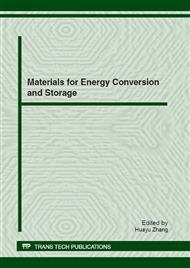p.160
p.164
p.169
p.174
p.179
p.184
p.188
p.193
p.197
Improvement in the Thermoelectric Properties by Ag/Sb Co-Substitution in PbSe
Abstract:
The thermoelectric properties of Ag-doped and Ag/Sb codoped PbSe, prepared by furnace melting, quenching, ball milling and spark plasma sintering (SPS) techniques, were investigated. The X-ray diffraction (XRD) analysis indicated that all samples crystallize in the NaCl-type structure without noticeable secondary phase. The substitution of Ag1+ ion for Pb2+ ion in PbSe caused the compound changed from n-type semiconductor to p-type semiconductor. The lower Ag doped sample Pb1-xAgxSe with x = 0.002 remains n-type conduction of PbSe, shows high electrical resistivity and thus low figure of merit (ZT). However, the higher Ag doped samples Pb1-xAgxSe with x = 0.004, 0.006, 0.008 exhibit n-type conduction, low electrical resistivity and thus leads to the higher ZT. The maximum ZT of the alloy Pb0.996Ag0.004Se reaches 0.66 at 673K, much higher than 0.24 of PbSe at the same temperature. A proper Sb doping in the n-type semiconductor Pb0.998Ag0.002Se can remain its n-type semiconductor, modify the carrier concentration, decrease the electrical resistivity and thus enhance the thermoelectric property. The alloy Sb0.002Pb0.998Ag0.002Se shows a ZT value of 0.59 at 573K, much higher than 0.26 of the sample Pb0.998Ag0.002Se at the same temperature.
Info:
Periodical:
Pages:
179-183
Citation:
Online since:
July 2012
Keywords:
Price:
Сopyright:
© 2012 Trans Tech Publications Ltd. All Rights Reserved
Share:
Citation:


